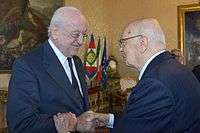Andrea Carandini
| Andrea Carandini | |
|---|---|
|
Andrea Carandini (left) with Giorgio Napolitano | |
| Born |
3 November 1937 Rome, Italy |
| Nationality | Italian |
| Fields | Archaeology |
| Institutions | Università di Roma "La Sapienza |
| Doctoral advisor | Ranuccio Bianchi Bandinelli |
Count Andrea Carandini (born November 3, 1937 in Rome, Italy) is an Italian professor of archaeology specialising in ancient Rome. Among his many excavations is the villa of Settefinestre.[1]
Biography
The son of Italian diplomat Count Nicolò Carandini (1896–1972), Andrea was born in Rome and has was a member of the faculty of the University of Rome La Sapienza beginning in 1963. Carandini was a student of Ranuccio Bianchi Bandinelli, completing his laurea in 1962 with a thesis on the Roman villa of Piazza Armerina. His research is focused on the topography of ancient Rome, Etruria in the Roman period, and the analysis of monumental complexes in various cities in Italy including Volterra, Grumentum, Pompeii, and Veii. Since 1993 he has coordinated a project in Rome's suburbium and the Tiber valley in conjunction with the Soprintendenza Archeologica and the Sovrintendenza Comunale di Roma. He continues to direct the excavations of the north slope of the Palatine Hill in Rome where important discoveries relating to the earliest city of Rome have been made, including the discovery of the famous Palatine wall in 1988.[2]
Carandini is the third cousin of actor Christopher Lee.[3]
In the 1990s Carandini was also involved in the excavation of the Auditorium site in Rome,[4] a substantial domestic structure dating to the fifth century B.C.; it is most likely to have been the monumental residence of an important clan (gens). Some of his views on the historicity of Romulus are controversial.[5][6]
Publications
- Ricerche sullo stile e la cronologia dei mosaici della Villa di Piazza Armerina (1964)
- La secchia Doria: una "storia di Achille" tardo-antica. Contributo al problema dell'industria artistica di tradizione ellenistica in Egitto. (1965)
- Vibia Sabina : funzione politica, iconografia e il problema del classicismo adrianeo (1969)
- Schiavi e padroni nell'Etruria romana : la Villa di Settefinestre dallo scavo alla mostra (1979)
- Archeologia e cultura materiale: dai lavori senza gloria nell'antichità a una politica dei beni culturali (1979)
- Esclaves et maîtres en Etrurie romaine : les fouilles de la villa de Settefinestre : catalogue de l'exposition (1981)
- Filosofiana, la villa di Piazza Armerina : immagine di un aristocratico romano al tempo di Costantino (1982)
- La Romanizzazione dell'Etruria : il territorio di Vulci (1985)
- Settefinestre : una villa schiavistica nell'Etruria romana (1985)
- Schiavi in Italia : gli strumenti pensanti dei Romani fra tarda Repubblica e medio Impero (1988)
- Storie dalla terra. Manuale di scavo (1981)
- Roma: Romolo, Remo e la fondazione della città (2000)
- Archeologia del mito. Emozione e ragione fra primitivi e moderni (2002)
- Paesaggi d’Etruria. La Valle dell’Albegna, la valle d’Oro e la Valle del Chiarore (2002, with F. Cambi)
- "Variations sur le thème de Romulus. Réflexions après la parution de l’ouvrage “La nascita di Roma”" (in De Boccard, La naissance de la ville dans l’Antiquité, 2003)
- "Il mito romuleo e le origini di Roma" (in M. Citroni, Memoria e identità. La cultura romana costruisce la sua immagine, 2003)
- La nascità di Roma. Dei, Lari, eroi e uomini all'alba di una civiltà (2003)
- Palatino, Velia e Sacra Via: Paesaggi urbani attraverso il tempo (2004)
- Remo e Romolo. Dai rioni dei Quiriti alla città dei Romani (775/750 - 700/675 a.C. circa) (2006)
- La leggenda di Roma (2006)
- "The Blessing of the Palatine and the Founding of Roma Quadrata," in Rome: Day One (2011), Princeton: Princeton University Press.
External links
- Martin G. Conde, Rome - Roman Forum: Prof. Andrea Carandini's Excavation in the Area of the House of Vestals. (2001-2007).
- Martin G. Conde, Rome - Archaeological news: Palatino, Lupercale, Lupa e Romolo e Remo(20.11.2007).[aggiornato / updated 22.12.2007]. Palatino, il tunnel segreto di Augusto (05.01.2008). Rapporto preliminare - Roma - Colle Palatino (MIBAC/SAR 16.02.2006).
References
- ↑ Andrea Carandini; M. Rossella Filippi (1985). Settefinestre: una villa schiavistica nell'Etruria romana. Panini.
- ↑ R. Suro. "Newly Found Wall May Give Clue To Origin of Rome, Scientist Says." New York Times June 10, 1988 http://www.nytimes.com/1988/06/10/world/newly-found-wall-may-give-clue-to-origin-of-rome-scientist-says.html
- ↑ http://www.eurobuch.com/buch/isbn/1156211875.html
- ↑ Andrea Carandini; Maria Teresa D'Alessio; Helga Di Giuseppe (2006). La fattoria e la villa dell'Auditorium nel quartiere Flaminio di Roma. L'ERMA di BRETSCHNEIDER. ISBN 978-88-8265-406-1.
- ↑ Andrea Carandini (2003). La nascita di Roma: dèi, lari, eroi e uomini all'alba di una civiltà. Einaudi. ISBN 978-88-06-16409-6.
- ↑ T. P. Wiseman. 2001. “Reading Carandini.” The Journal of Roman Studies 91:182-193 http://www.jstor.org/stable/3184776
